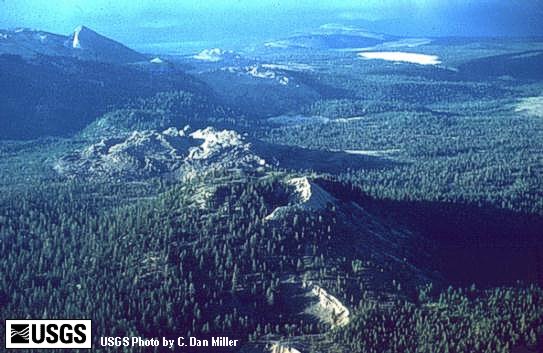
Aerial view of the Inyo Vicinity, Long Valley, California
|
Long Valley Caldera Volcano Information
|
-
Link to:
 Long Valley Observatory Website
Long Valley Observatory Website
-
America's Volcanic Past - California
-- Volcanic Highlights and Features
Long Valley Caldera
Mammoth Mountain
Mono and Inyo Craters
plus other National Parks and Monuments in California
-
Long Valley Caldera
About 760,000 years ago a cataclysmic volcanic eruption in the Long Valley, California area blew out 150
cubic miles of magma (molten rock) from a depth of about 4 miles beneath the Earth's surface. Rapidly
moving flows of glowing hot ash covered much of east-central California, and airborne ash fell as far east as
Nebraska. The Earth's surface sank more than 1 mile into the space once occupied by the erupted magma,
forming a large volcanic depression that geologists call a caldera. Today, Long Valley occupies the eastern
half of this 10-mile-wide, 20-mile-long caldera. Magma still underlies the caldera and heats underground
water. The heated water feeds local hot springs and natural steam vents and drives three geothermal power
plants, producing a combined 40 megawatts of electricity.
-- Excerpt from:
Hill, et.al., 1996, Living With a Restless Caldera -- Long Valley, California: USGS Fact Sheet 196-96
-
Mammoth Mountain
Long Valley, from the headwaters of Owens River to Lake Crowley, is a giant volcanic caldera. Mammoth
Mountain - a massive volcanic dome - has grown on the caldera margin. Mammoth Mountain was built by
eruptions between about 200,000 and 50,000 years ago.
-- Excerpt from:
USGS Long Valley Observatory Website, October 2000 and
USGS/NPS Geology in the Parks Website, August 2001
-
Mono and Inyo Craters
The massive Long Valley eruption (see above) was followed by hundreds of smaller eruptions over the next
few hundred thousand years. These eruptions of lava flows, domes, and pyroclastic flows were concentrated
in the central and western parts of the caldera. Volcanic activity then moved northward to the Mono Lake
area about 35,000 years ago to build the Mono Craters. The most recent eruptions in the area occurred from
the Mono and Inyo Craters about 600 years ago, and from Negit Island in Mono Lake about 250 years ago.
-- Excerpt from:
USGS Long Valley Observatory Website, October 2000
-

[Map,20K,InlineGIF]
Major West Coast Volcanoes - Washington, Oregon, and California
-

[Map,18K,InlineGIF]
Long Valley Caldera, Mono Crater, and Inyo Craters
-- Modified from: USGS-Menlo Park
|
Just off the north shore of the Mono Lake lies another interesting volcano:
Black Point. A low,
mesa-like mountain of black ash,
Black Point erupted 12,000 years ago following the last ice age,
when Mono Lake swelled to five times its
current size and nearly ten times its current depth.
At that time of its eruption, Black Point was located under water, which probably
accounts for its unusual flattened top and the 80' deep, 5' wide cooling
fissures that puncture its southwestern face.
The hike to the top of Black Point is not an easy one;
consider this an exploration, an adventure!
There are no trails or signs to show you where to go.
You will be walking through the cinders and ash of the volcano and sometimes
progress will be difficult.
If you persevere, your discovery of the fissures will seem even more
spectacular because their remoteness.
The fissures cut across the cap of Black Point in a roughly north-south direction.
The best route of travel is to meander up the contours,
walking south and west. From the high point (benchmark triangle on map),
the fissures are to the southwest.
Remember, you are hiking at an elevation of nearly 7000 feet.
If you come from a lower elevation, you may find the climbing particularly
exhausting. Plan to allow ample time to enjoy the walk up (about 45 minutes),
to explore the fissures and to return (about 3 hours total).
Boots or high topped shoes will increase your comfort by keeping the sand out.
Wearing a hat and carrying water are good ideas because
you will not find any shade until you reach the fissures.
Please watch your step; there are no guard rails or signs.
You can help make this experience pleasurable for others by carrying out your
trash and by picking up any you find there.
Excerpts from:
U. S. Forest Service Website, Inyo National Forest, 2001
|
-
LVO - Long Valley Observatory
-- Link courtesy USGS Long Valley Observatory
-
Inyo National Forest
-- Link courtesy U. S. Forest Service
-
MORE Useful Sites
-- CVO Menu, includes links to Volcano Info, Seismicity, Hydrology, etc.
-
Travel and Tourism Links
-- CVO Menu, includes links to Nearby Cities, Attractions, Recreation, etc.
-
Weather and Road Conditions
-- CVO Menu, includes links to Weather Forecasts, DOT's, Pass Reports, Snow Depths,
etc.
-
 California Volcanoes and Volcanics Menu
California Volcanoes and Volcanics Menu
|



